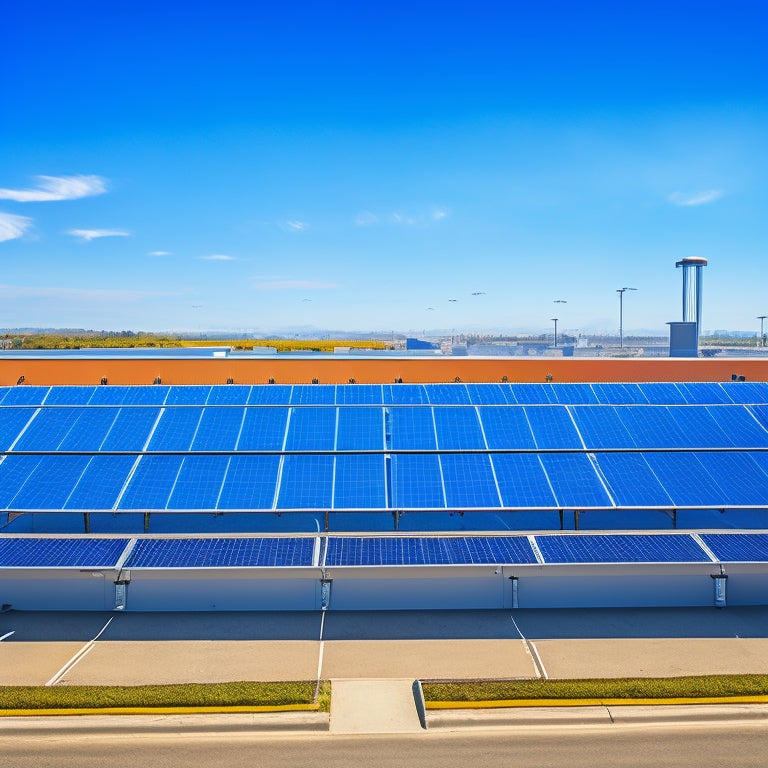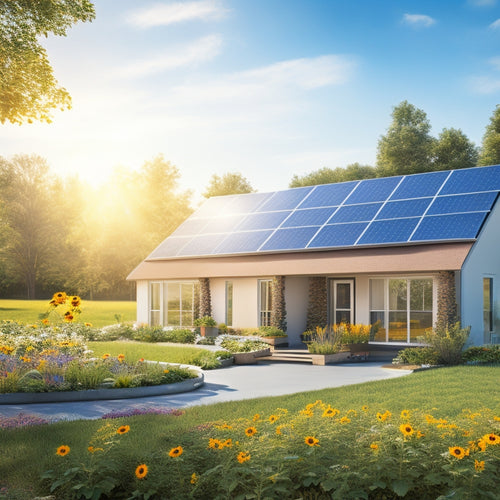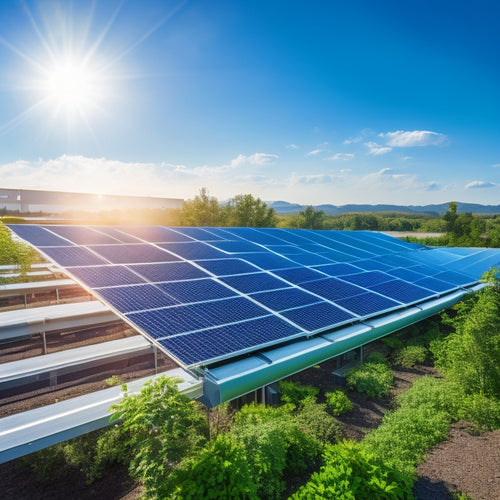
7 Essential Components of a Commercial Solar System
Share
When planning a commercial solar system, focus on seven key components. First, select the right solar panels—monocrystalline for highest efficiency. Choose between micro or string inverters based on energy output and reliability. Mounting systems need to match your space and durability needs. Battery storage guarantees efficiency and reliability by holding excess energy for later use. A robust monitoring system detects performance issues instantly. Proper wiring and electrical components guarantee a reliable and organized setup. Finally, install safety equipment like surge protectors and arc fault breakers for hazard prevention. Each component is vital to an excellent solar setup.
Key Takeaways
- Solar panels convert sunlight into electrical energy and come in types such as monocrystalline, polycrystalline, and thin-film.
- Inverters convert DC power from solar panels to AC power, with options including micro inverters and string inverters.
- Mounting systems secure solar panels in place, with options like ground mounts and roof mounts.
- Battery storage systems store excess energy for use during low sunlight or high demand periods.
- Safety equipment, including grounding techniques, DC isolators, and surge protectors, prevent electrical faults and ensure system safety.
Solar Panels
Solar panels, the primary component of a commercial solar system, convert sunlight into electrical energy through photovoltaic cells. Understanding the different solar panel types is vital for maximizing efficiency and return on investment. You'll typically encounter three main types: monocrystalline, polycrystalline, and thin-film.
Monocrystalline panels are made from a single crystal structure, offering the highest efficiency rates and longevity. They're ideal for commercial installations where space is limited but high-output is essential.
Polycrystalline panels, formed from multiple crystal fragments, provide a cost-effective alternative with moderate efficiency. They're suitable for larger installations where space isn't as constrained.
Thin-film panels, composed of photovoltaic cells layered on a substrate, offer the advantage of flexibility and lower weight. While their efficiency is generally lower than crystalline types, they perform well in diverse environmental conditions and can be applied to unconventional surfaces.
Each solar panel type has its strengths and trade-offs. For instance, while monocrystalline panels excel in efficiency, they come at a higher cost. Polycrystalline panels offer a balance between cost and efficiency, and thin-film panels shine in versatility and weight considerations.
Inverters
You need to understand the different types of inverters and their specific applications to optimize your commercial solar system.
Evaluate the efficiency and performance metrics to guarantee maximum energy conversion rates.
Additionally, consider the installation and maintenance requirements to maintain system reliability and longevity.
Types of Inverters
Understanding the types of inverters is essential for optimizing the efficiency and reliability of a commercial solar system. Primarily, you'll encounter two main types: micro inverters and string inverters. Each serves distinct functions and has specific advantages depending on your system's configuration and performance requirements.
Micro inverters are installed at each solar panel, converting direct current (DC) to alternating current (AC) on a per-panel basis. This setup allows for independent operation of each panel, ensuring that shading, dirt, or malfunctions on one panel don't impact the others. Micro inverters are particularly beneficial for complex rooftops with varying angles and shading issues, offering enhanced system reliability and modularity.
String inverters, on the other hand, connect a series of panels (a string) to a single inverter. This centralized approach is cost-effective and simpler to install but comes with a caveat: the performance of the entire string is affected by the weakest panel. Therefore, string inverters are ideal for installations with uniform sunlight exposure and minimal shading.
Selecting between micro inverters and string inverters depends on your specific site conditions, desired performance, and budget constraints. Both types offer unique benefits, and understanding these can guide you in making an informed decision for your commercial solar system.
Efficiency and Performance
Evaluating the efficiency and performance of inverters is vital for optimizing the energy yield and reliability of a commercial solar system. You'll need to assess several key factors to make sure you're getting the most out of your system.
First, take into account the energy output. An inverter's efficiency directly impacts how much solar energy gets converted into usable electricity. High-efficiency inverters minimize energy loss, maximizing your system's overall performance.
Secondly, temperature effects play an important role. Inverters can experience reduced efficiency at higher temperatures, so it's important to choose models that offer good thermal management or are designed for high-temperature environments.
Additionally, look into the inverter's maximum power point tracking (MPPT) capabilities. An effective MPPT system ensures that the inverter operates at the best voltage and current levels, further enhancing energy output.
Lastly, reliability and lifespan of the inverter should be taken into account. A robust inverter will offer consistent performance over many years, reducing the need for frequent replacements and maintenance.
Key factors to consider:
-
Energy output: Efficiency ratings and conversion rates.
-
Temperature effects: Thermal management and high-temperature performance.
-
MPPT capabilities: Optimization of voltage and current.
- Reliability: Longevity and consistent performance.
Installation and Maintenance
When installing inverters for a commercial solar system, make sure that they're positioned in a well-ventilated area to prevent overheating and maintain peak performance. Proper airflow ensures that the inverters operate efficiently and prolongs their lifespan. Additionally, consider ease of access for maintenance purposes.
Before you begin the installation, familiarize yourself with local permit requirements. These regulations can vary greatly by region and may impact where and how you can install inverters. Acquiring the necessary permits in advance can save time and prevent legal complications.
Once installed, establish a strict inspection schedule. Regular inspections are important for identifying potential issues early, such as electrical faults or thermal buildup. A thorough maintenance plan should include checking connections, cleaning components, and verifying inverter performance metrics.
Keep detailed records of each inspection and any maintenance performed. These logs aren't only useful for tracking performance but may also be needed for warranty claims.
Mounting Systems
A commercial solar system's mounting system secures solar panels in place, ensuring ideal orientation and stability. When selecting mounting systems, you have two primary options: ground mounts and roof mounts. Ground mounts offer flexibility in positioning and can be adjusted for ideal sun exposure. Roof mounts, on the other hand, are cost-effective and utilize existing space. The choice between these largely depends on your facility's specific needs and constraints.
To help you understand better, here are some key considerations:
-
Durability: Mounting systems must withstand various weather conditions. Look for corrosion-resistant materials and robust construction.
-
Ease of Installation: Some systems are designed for quicker, simpler installation, reducing labor costs and downtime.
-
Adjustability: Adjustable mounts allow for fine-tuning the angle and direction of the panels, maximizing efficiency throughout the year.
- Compatibility: Ensure the mounting system is compatible with the type and size of solar panels you're using.
With a focus on precision and ideal performance, selecting the right mounting system is essential for the long-term success of your commercial solar installation. By considering these factors, you guarantee your solar panels are both secure and efficient.
Battery Storage
Battery storage plays an essential role in optimizing the efficiency and reliability of a commercial solar system. By integrating a storage solution, you can store excess energy generated during peak sunlight hours and use it during periods of low sunlight or high demand. This approach maximizes energy utilization and reduces dependency on the grid.
When evaluating battery storage, consider battery capacity, which determines how much energy the battery can store. Properly sizing your battery capacity guarantees you effectively meet your energy storage needs. Additionally, the type of battery technology—such as lithium-ion or lead-acid—affects efficiency, lifespan, and performance.
Below is a table summarizing key aspects of battery storage:
| Aspect | Description |
|---|---|
| Battery Capacity | The amount of energy the battery can store and deliver. |
| Energy Storage | The process of storing generated energy for later use. |
| Battery Technology | Types of batteries, e.g., lithium-ion or lead-acid, influencing performance. |
| Efficiency | The ratio of stored energy to the energy available for use. |
| Lifespan | The operational life of the battery under typical usage conditions. |
Monitoring Systems
You should utilize monitoring systems to guarantee peak performance of your commercial solar setup. These systems provide real-time energy tracking and allow for thorough performance data analysis.
Real-time Energy Tracking
Real-time energy tracking systems provide precise monitoring and analysis of a commercial solar system's performance, ensuring peak efficiency and quick identification of any issues. By leveraging these systems, you can optimize cost savings and reduce your environmental impact. Tracking real-time data allows you to make informed decisions and swiftly address any anomalies, thereby maintaining the overall health of your solar system.
A robust real-time energy tracking system offers several advantages:
-
Immediate detection of performance issues: Quickly identify and resolve faults, minimizing downtime and maximizing energy production.
-
Enhanced energy management: Monitor energy consumption patterns to adjust usage and conserve energy, leading to substantial cost savings.
-
Compliance and reporting: Easily generate reports for regulatory compliance and sustainability goals, showcasing your commitment to reducing environmental impact.
- Predictive maintenance: Use historical data and trends to anticipate potential failures, allowing for proactive maintenance and reducing unexpected repair costs.
Performance Data Analysis
In analyzing performance data, monitoring systems play a crucial role in guaranteeing the peak functionality and efficiency of commercial solar installations. These systems provide you with real-time insights into your solar arrays' performance, allowing you to identify inefficiencies and potential issues swiftly. By utilizing data visualization tools, you can easily interpret complex data sets, transforming them into actionable insights that drive informed decision-making.
Monitoring systems don't just stop at current performance; they also facilitate predictive maintenance. This means you'll get alerts about potential failures before they cause significant downtime or damage. These systems analyze historical data and identify patterns that could indicate future problems, enabling you to schedule maintenance proactively rather than reactively. This approach minimizes operational disruptions and extends the lifespan of your solar equipment.
Moreover, the precision of these systems ensures that you can pinpoint the exact location and nature of any issue, whether it's a drop in energy production or a hardware malfunction. This targeted approach not only conserves resources but also maximizes the return on your solar investment.
Wiring and Electrical Components
Understanding the wiring and electrical components of a commercial solar system is essential for ensuring efficient energy conversion and safety. You'll need to start with detailed wiring diagrams to map out the connections between solar panels, inverters, and the main power grid. These diagrams are important for visualizing the overall system and troubleshooting any issues that may arise.
Electrical conduits are another critical component. They protect the wiring from physical damage and environmental factors, ensuring the durability and reliability of your system. Properly installed conduits also help in maintaining a neat and organized setup, which is necessary for both aesthetic and functional reasons.
Key components you should focus on include:
-
Wiring Diagrams: These provide a detailed map of electrical connections, essential for both installation and maintenance.
-
Electrical Conduits: Protect wiring from damage and environmental factors, ensuring long-term system reliability.
-
Inverters: Convert the DC power generated by solar panels into AC power for use in commercial applications.
- Junction Boxes: Serve as central points where multiple wiring connections are made, facilitating easier maintenance and troubleshooting.
Safety Equipment
Ensuring the safety of your commercial solar system requires meticulous attention to specialized equipment designed to protect both the system and its users. You need to implement advanced grounding techniques to prevent electrical faults. Grounding provides a path for excess electricity to disperse safely into the earth, minimizing the risk of electric shocks and equipment damage. Proper grounding involves using copper rods, grounding conductors, and ensuring all components are bonded correctly to the grounding system.
Fire prevention is another vital aspect. Installing DC isolators helps you quickly disconnect the solar panels from the rest of the system in case of an emergency. Surge protectors can safeguard against voltage spikes, which could otherwise lead to fires. Additionally, arc fault circuit interrupters (AFCIs) detect and mitigate arc faults, a common cause of electrical fires, by automatically shutting down the affected circuit when a fault is detected.
Moreover, regular maintenance and inspections are essential for identifying potential hazards early. By integrating these safety measures, you'll not only protect your investment but also safeguard the safety of everyone in the vicinity. A well-designed safety protocol is indispensable for the long-term viability of your commercial solar installation.
Frequently Asked Questions
How Long Does the Installation Process Take From Start to Finish?
The installation process typically takes 3-6 months. System sizing and obtaining installation permits are essential steps that influence the timeline. Proper planning guarantees efficiency, reducing potential delays and optimizing your commercial solar system's performance.
What Are the Maintenance Requirements for a Commercial Solar System?
So, you thought solar panels were maintenance-free? Think again! You'll need regular cleaning—monthly, ideally. Plus, component inspections every six months keep everything running smoothly. Don't worry, you'll get used to it.
Are There Any Tax Incentives or Rebates Available for Commercial Solar Installations?
You'll find significant Federal incentives and various State rebates available for commercial solar installations. These can substantially offset your initial costs, making solar energy a more viable and cost-effective option for your business.
How Does Weather Affect the Efficiency of a Commercial Solar System?
'Every cloud has a silver lining. Seasonal variations and temperature fluctuations greatly affect your commercial solar system's efficiency. Peak performance occurs in cooler temperatures with adequate sunlight, while extreme heat or persistent cloud cover can reduce output.'
What Is the Expected Lifespan of a Commercial Solar System?
A commercial solar system's expected lifespan typically ranges from 25 to 30 years. Component durability and warranty periods are key factors; most warranties cover 20 to 25 years, ensuring long-term performance and reliability for your investment.
Conclusion
When designing a commercial solar system, think of each component like a well-oiled machine part, working in harmony to achieve peak efficiency.
Solar panels capture sunlight, while inverters convert it to usable electricity.
Mounting systems secure panels, and battery storage guarantees energy availability.
Monitoring systems track performance, wiring connects everything, and safety equipment safeguards it all.
By understanding these elements, you can optimize your solar investment for maximum returns and sustainability.
Related Posts
-
Trends in Renewable Energy Storage Technologies
You're witnessing rapid advancements in renewable energy storage technologies aimed at improving efficiency and scala...
-

Home Solar Systems for Environmental Impact
Home solar systems markedly reduce your carbon footprint by utilizing renewable energy. By adopting solar energy, you...
-

Solar Energy Efficiency Improvements for Businesses
Improving solar energy efficiency for your business can lead to considerable cost savings and enhance your sustainabi...

